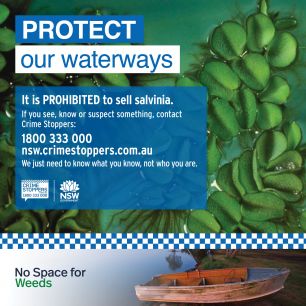
Water weeds in NSW
Seen water weeds for sale? Contact Crime Stoppers.
NSW Crime Stoppers is appealing to the community to report the trade of frogbit, salvinia and water hyacinth.
Trading these plants is prohibited and must be stopped. If you see, know or suspect criminal activity, contact NSW Crime Stoppers in complete confidence on 1800 333 000.
How are water weeds introduced?
Water weeds have been deliberately introduced through the nursery and aquarium plant industry for display in backyard ponds and aquariums. Species such as water hyacinth and cabomba have primarily been spread by humans into our natural waterways.
Boating or fishing in weed infested waterways has also contributed to the spread of water weeds from one site to another. Propellers and anchors can cut plants into fragments and spread them within and between waterbodies. Fragments can spread from an infested waterbody to a weed free waterbody by attaching to watercraft, trailers and fishing equipment. Some weeds can survive considerable time out of water and a single plant fragment can start a new infestation.
What species are pests?
View a list of water weeds in NSW.
Water weeds can:
- Alter dissolved oxygen levels reducing the water quality
- Restrict navigation and recreational activities on waterways
- Pose a drowning hazard for livestock and recreational swimmers
What is NSW DPI doing about water weeds?
The NSW government funds a state weed program targeted specifically at water weeds. This program assists in delivering community education, awareness and extension programs; provides technical support to key stakeholders; and coordinates state strategies for high priority aquatic weeds.
Water weeds are predominantly spread throughout the river systems flowing along the east coast of NSW. Many western flowing river systems are currently free of major weed infestations. It is therefore the key priority of DPI to ensure that these regional river systems remain free of aquatic weeds. In 2010 we have seen 5 new water weed infestations within the Murrumbidgee, Murray and Warrego river networks. It is vital that people report any suspicious water weed infestation to protect the states water resources from weed invasion.
Help stop the spread of water weeds!
Members of the public, including fishers, divers and members of local environmental groups, are often the first to discover a new exotic weed or the fact that an existing weed has spread into a new area. This information can be very valuable in helping to manage weed problems.
You can protect our waterways and native fish by helping to stop the introduction and spread of water weeds into new areas by:
- Preventing unwanted hitchhikers – Inspect and remove any plant fragments from watercraft, trailers and all equipment before leaving a site or launching at a new site.
- Not accessing waterbodies in infested areas and if in an infested area avoid running the engine through weed beds.
For backyard pond owners:
- Prevent accidental escapes – screen outdoor ponds to prevent overflow during heavy rains.
- Source your pond plants from reputable and/or accredited nurseries/sellers.
- Never dump pond plants in the green waste or local water way, dry specimens thoroughly then dispose in a sealed bag.
For everybody:
- Keep a lookout for suspected new water weeds in your local waterways.
- Report suspicious water weeds to the local council weeds officer or phone the NSW Invasive Plants and Animals Enquiry Line on 1800 680 244 or email weeds@dpi.nsw.gov.au


